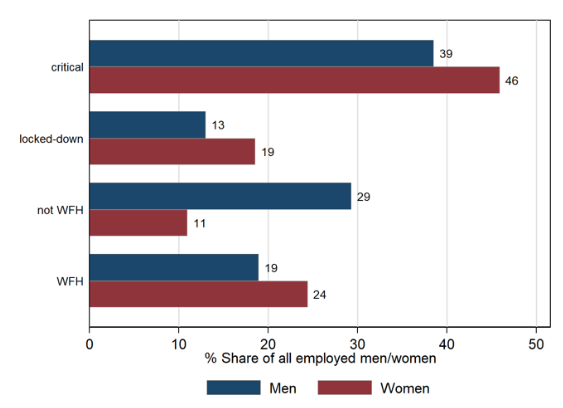COVID-19 is hitting most economies as hard as the deepest recessions, but given the exceptional nature of this crisis, the distribution of jobs and workers affected is potentially different from previous recessions.1 Sectors whose activities involve social contact, such as retail, restaurants and hospitality – to name a few – have been shut down, with temporary or permanent job losses concentrated among low-skill service workers. At the same time, other sectors, such as healthcare, food production and distribution and protective services, have been defined as critical to the COVID-19 response, and their activity is maintained at or above full capacity.
Market work
While the Great Recession, as well as other previous downturns, seemed to more severely affect male-dominated industries such as construction and manufacturing, the social distancing and lockdowns associated with the COVID-19 crisis has naturally hit service sectors with frequent interactions between consumers and providers, in which women tend to be over-represented. But even among workers whose activities are not directly subject to lockdown, many are unable to work as normal as their work would not comply with social distancing (e.g. in construction, repairs and home services) and can hardly be performed from home.
Figure 1 gives a snapshot of the distribution of job attributes for men and women in the UK, through the lens of the incidence of COVID-19. The data used combine sector-level information on critical and locked-down jobs from the UK Labour Force Survey (April-June 2019) and occupation-level information on which activities can be performed from home, obtained by matching information on tasks in O-NET (from Dingel and Neiman 2020) with the UK classification of occupations in the LFS.
Figure 1 The composition of jobs according to COVID-19 incidence
Notes. Sample: employed men and women. The bars show the incidence of critical jobs and locked-down jobs, as well as the incidence of working from home among those not in critical or locked-down jobs. For completeness, the percentage of critical jobs that can be done from home is 44 for men and 41 for women, and the percentage of locked-down jobs that can be done from home is 22 for men and 24 for women.
Source: UK LFS, April-June 2019.
About 39% and 46% of working men and women, respectively, are employed in critical sectors, while 13% and 19%, respectively, are in locked-down sectors.2 For the remaining 48% of men and 35% of women, the likelihood of avoiding earnings losses is closely linked to their ability to work from home. This is largely the case for female-dominated sectors like education, but it is not the case for male-dominated sectors like construction, repairs, and large parts of manufacturing. Thus it is unsurprising that about 29% of men but only 11% of women are in jobs that cannot be done from home, while not directly subject to the lockdown. According to a survey by Adam-Prassl et al. (2020), workers who can perform all of their tasks from home appear to be insured against job loss during the current crisis but still suffer some earnings losses, presumably via reduced workloads. And whether or not they work from home, women face a slightly higher likelihood than comparable men of losing their jobs and/or report lower earnings. All factors considered, it seems therefore that – unlike previous recessions – the current crisis is harming women’s labour market prospects more than those of men.
Home production
One unique feature of the COVID-19 crisis has been its impact on the volume of home production, reversing by decree a secular process of marketisation of childcare and home keeping. With the start of the lockdown, virtually none of the typical components of home production can be outsourced to the market, and the closure of schools and nurseries has added all education and childcare services to pre-existing home production needs.
The impacts of COVID-19 on the gender distribution of home production depends on various factors. First, the incidence of increased childcare needs is shaped by individuals’ household composition. In particular, women are more likely than men to raise children as single parents. In the UK, 20.3% of households with dependent children (aged 15 or below) are headed by single mothers, against 3.3% headed by single fathers. Hence women are more likely than men to be the sole providers of the sharp increase in childcare during the lockdown.
Second, the distribution of home production depends on the working status of one’s partner (if any), which is itself affected by the crisis. Figure 2 shows the distribution of partner’s status for women with dependent children. Among mothers in critical jobs, representing about one third of the total, 57% have either no partner or a partner who also works in a critical job, and hence mostly rely on basic childcare services guaranteed by the education system to parents in critical jobs. The remaining 43% have a partner who is staying at home – whether they are employed in a locked-down sector (6%), cannot go to work due to social distancing (33%), or does not work at all (4%). In these households, we would expect a reversal of the home production gap, with men taking over the bulk of increased childcare and housekeeping needs. Among mothers who are not in critical jobs, and therefore stay at home during the lockdown, 47% have no partner at home, and hence are likely to be fully in charge of home production. The other 53% have a stay-at-home partner, and home production is somehow shared between spouses.
Figure 2 The distribution of partner’s status, by women’s status
Notes. Sample: Women with dependent children. The “other” status indicates women staying at home during COVID-19 (including: in locked-down jobs, in non-critical jobs, not employed).
Source: UK LFS, April-June 2019.
There is plenty of pre-COVID-19 evidence on the contribution of men and women to home production from time use data. According to a 2015 time-use survey for the UK, women do 27 hours per week of home production on average, while men do 16 hours on average. Among households with dependent children, weekly home production hours are 40 for mothers and 20 for fathers, of which 16 and 8 hours, respectively, involve childcare. If the additional home production falls on men and women according to baseline specialisation patterns, women are at the receiving end of the bulk of increased home production requirements.
There is no comprehensive evidence on the time use of spouses since the onset of the crisis, but Aguiar et al. (2013) show that, during the Great Recession, women allocated a larger portion of reduced market hours to childcare and housekeeping, and recent evidence collected by Adams-Prassl et al. (2020) shows that, during the current lockdown, mothers are doing about 1 hour and 30 minutes extra childcare on a typical workday relative to men. This is larger than the corresponding 1 hour and 9 minutes differential among comparable individuals at baseline, providing suggestive evidence that the higher childcare load has, on average, widened existing inequalities in gender contributions to home production.
Potential long-lasting consequences
Several of the impacts discussed are temporary in nature and can in principle be reversed with the end of the lockdown and the restart of usual economic activity. But given the recent radical changes to the organisation of work and family life, it is natural to reflect on potentially permanent consequences of the crisis beyond the current lockdown via learning, habit formation and the evolution of social norms. First, the massive increase in the incidence of working from home has suddenly accelerated a pre-existing but slowly evolving tendency towards smart working and flexible work arrangements. The number of people working from home in the UK has risen from 2.9 million in 1998 to 4.2 million in 2014, representing 14% of employment, and an additional 1.8 million people report they would prefer to work from home if they were given the choice.3 According to a recent survey, 86% of UK managers foresee organisational barriers to the adoption of flexible working in their workplaces (CIPD 2019), but it is possible that some of the perceived barriers will be eventually cracked by actual remote work patterns implemented during COVID-19.
The supply and demand of remote work varies across genders. In the UK, 48% of women are in jobs that can be done from home, compared to 39% of men. Due to heavier household responsibilities, women also value flexible work schedules and shorter commutes more than men (Mas and Pallais 2017, Le Barbanchon et al. 2019), and thus may be more beneficially affected by remote working opportunities. But while remote working may provide women with the flexibility to combine market work and family commitments, it may also lead them to specialise in low- or middle-tier jobs that are more permeable to informal work arrangements. Furthermore, remote working may dilute employee presence and attachment to the workplace, with possibly detrimental impacts on career progression.
Second, the increased home production needs may substantially shift the allocation of childcare and housekeeping in households in which the husband is forced at home by the lockdown. There is evidence that the spousal allocation of home production is shaped in large part by social norms on gender roles, and that gender identity norms are only slowly evolving. But evidence has also shown that ‘forced’ changes in gender roles may have permanent consequences beyond short-term circumstances, by accelerating the evolution of norms and eroding gender comparative advantages. For example, male mobilisation in the US during WWII induced more women to enter the labour market during the war, and thereby shaped the norms and preferences of younger generations who were exposed to those early labour market entrants (Fernandez et al. 2004). In the UK, 63% of fathers are staying at home during the lockdown, and about one third of these live with women working long hours in critical sectors. One would expect a substantial redistribution of home production loads in these households during the crisis, and one should wonder whether the emergency would ease the breakdown of traditional gender roles come the recovery.
References
Adams-Prassl, A, T Boneva, M Golin and C Rauh (2020). “Inequality in the impact of the coronavirus shock: Evidence from real-time surveys.” Mimeo.
Aguiar, M, E Hurst and L Karabarbounis (2013). “Time use during the Great Recession.” American Economic Review 103: 1664-1696.
Alon, T, M Doepke, J Olmstead-Rumsey and M Tertilt (2020). “The impact of COVID-19 on gender equality.” NBER Working Paper No. 26947
Bell, B, N Bloom, J Blundell and L Pistaferri (2020). “Prepare for large wage cuts if you are younger and work in a small firm”. VoxEU.org, 6 April.
CIPD (2019). Megatrends: Flexible working.
Dingel, J and B Neiman (2020). “How many jobs can be done at home?” NBER Working Paper No. 26948.
Fernandez, R, A Fogli and C Olivetti (2004). “Mothers and sons: Preference formation and female labor force dynamics.” Quarterly Journal of Economics 119: 1249-1299.
Le Barbanchon, T, R Rathelot and A Roulet (2019). “Gender differences in job search: Trading off commute against wage.” Mimeo.
Mas, A and A Pallais (2017). “Valuing Alternative Work Arrangements.” American Economic Review 107: 3288-3319.
Endnotes
1 See Alon et al. (2020), Adam-Prassl et al (2020) and Bell et al (2020) for recent work on COVID-19 impacts on gender inequalities and low-wage labour markets.
2 The classification of sectors into critical and locked-down is based on UK Government’s guidelines on “critical workers” and “businesses that must remain closed”.
3 https://www.thehrdirector.com/business-news/health-and-wellbeing/four-million-working-from-home/





